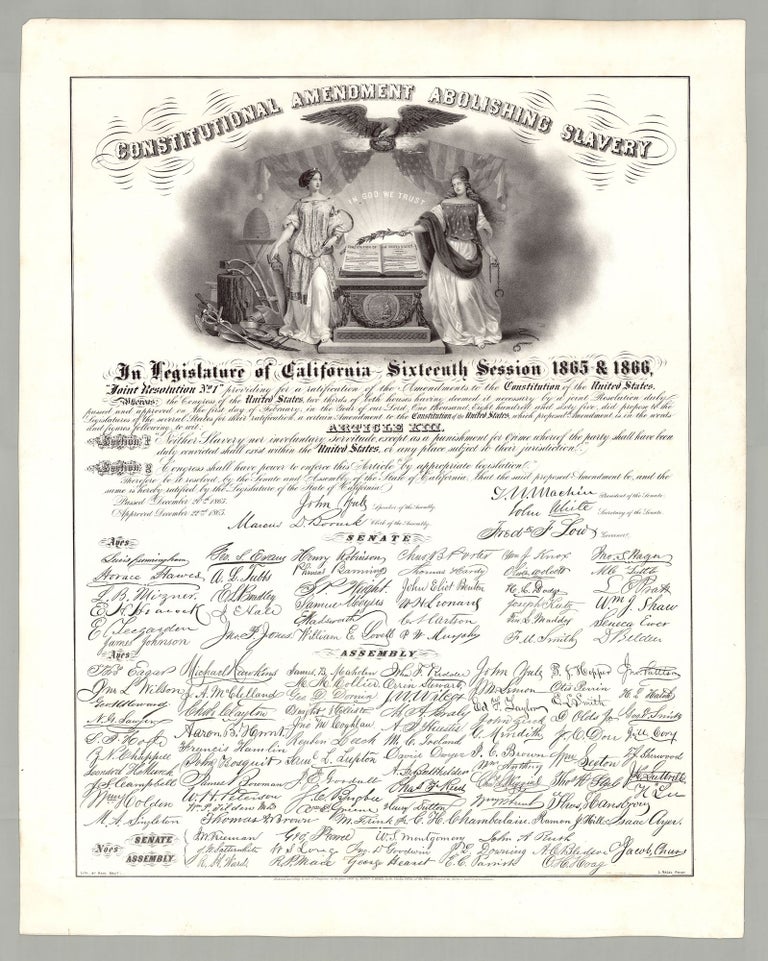Constitutional Amendment Abolishing Slavery.
[San Francisco]: California: Nahl Bros., litho., L. Nagel, print., 1866. Illustrated lithographic broadside, printed area, 25.5” x 19.5”, sheet-size, 29.5” x 23”, image size, 8” x 14”. A rare and visually striking broadside reproducing the joint resolution passed by the legislature of the state of California to ratify the Thirteenth Amendment, including the facsimile signatures of those who voted both for and against it. The 13th Amendment to the U.S. Constitution was the first of the three ‘Reconstruction Amendments’ which established the legal framework for abolition. Universal abolition was achieved through ending slavery (the 13th); defining citizenship and establishing due process and equal protection (the 14th), and establishing the right to vote for African American men (the 15th). The 13th passed in the State of California on 20 Dec. 1865, and was approved two days later. This broadside prints the language of the resolution, including the two sections of the 13th Amendment (here termed ‘Article XIII’): Section I, stipulating that “Neither slavery nor involuntary servitude, except as a punishment for crime whereof the party shall have been duly convicted shall exist within the United States, or any place subject to their jurisdiction”; and Section II, “Congress shall have power to enforce this Article by appropriate legislation.” Below the resolution are the facsimile signatures of various state officials, including Governor Frederick Low, and those in the California State Senate and Assembly who voted in favor of the amendment (constituting the vast majority), above the signatures of those few who voted against the Amendment (four senators and eleven assemblyman). An allegorical image at the top features Lady Liberty, holding a broken chain in one hand, and in the other hand extending an olive branch across the U.S. Constitution in the form of a book toward a woman representing industry, agriculture and trade, the implements of which lie about her. The open book rests on a podium featuring the seal of the state of California. The 13th Amendment grew out of Lincoln’s 1863 Emancipation Proclamation, which was a wartime measure issued by Lincoln as commander-in-chief, and thus not an act of Congress. The first of many Congressional bills to carry out universal abolition was introduced in Dec. 1863 by Representative James Ashley of Ohio (its final version being passed by the Senate in April 1864). The proposed amendment to the Constitution languished in the House until Jan. 1865, following which it was sent to the states for ratification. By the end of Feb. 1865, eighteen states had ratified it—nine short of the two-thirds needed under Article V of the Constitution. Full ratification did not occur until Dec. 1865, when the ex-Confederate state of Georgia became the necessary twenty-seventh state (final certification coming on 18 Dec. 1865). California ratified in Dec. 1865, with Oregon, Florida, Iowa and New Jersey following in the next few months. Born in Germany, Charles Nahl (1818–1878) and his brother Arthur Nahl (1820–1889) studied in Paris, and emigrated to America in 1849. Working chiefly as artists and photographers, they established a lithographic company in San Francisco, operating from 1851 to 1872. Also born in Germany, Louis Nagel (ca. 1817–?) immigrated to America in the 1840s and first worked in New York. In the 1850s, he moved to San Francisco, where he documented the California scene through maps and lithographed city views. In his own company and in partnership with others, he printed numerous works drawn by the Nahl brothers. Nagel was in business as a lithographer until the mid-1860s. OCLC records just three copies, all held by California institutions. REFERENCES: Dauphin, Gary. #blackhistory: On February 1, 1865, Abraham Lincoln signed the 13th Amendment to the U.S. Constitution (February 1, 2020) at caamuseum.org; Last, Jay. The Color Explosion : Nineteenth-Century American Lithography (Santa Ana, CA, 2005), pp. 119 and 214. CONDITION: Very good, light wear, mild toning and foxing.
Item #6353
Sold


